Nestle's Approach to Recruitment, Selection, and Employee Training
VerifiedAdded on 2021/02/21
|34
|7559
|133
Report
AI Summary
This report provides a comprehensive analysis of Nestle's approach to recruitment, selection, and training of employees, aiming to meet international requirements. The report begins with an introduction outlining the importance of these processes and sets the aim to analyze the impact of multinational organizations in improving employee capability. It explores Nestle's internal selection processes, including skill tests and interviews, along with the associated costs. The report details various training methods employed by Nestle, such as induction, orientation, on-the-job, and off-the-job training. It then outlines a project management plan, including cost, scope, time, quality, communication, and risk considerations, as well as resource allocation. A literature review examines how Nestle improves recruitment, selection, and training, and how these practices help the company meet international requirements. The study also highlights the types of training provided to Nestle employees. Furthermore, the report includes a work breakdown structure (WBS) to break down project activities, and a Gantt chart to schedule the project activities, offering a detailed look at how Nestle manages its workforce to achieve its goals.

Managing a
Successful Business
Project
Successful Business
Project
Paraphrase This Document
Need a fresh take? Get an instant paraphrase of this document with our AI Paraphraser

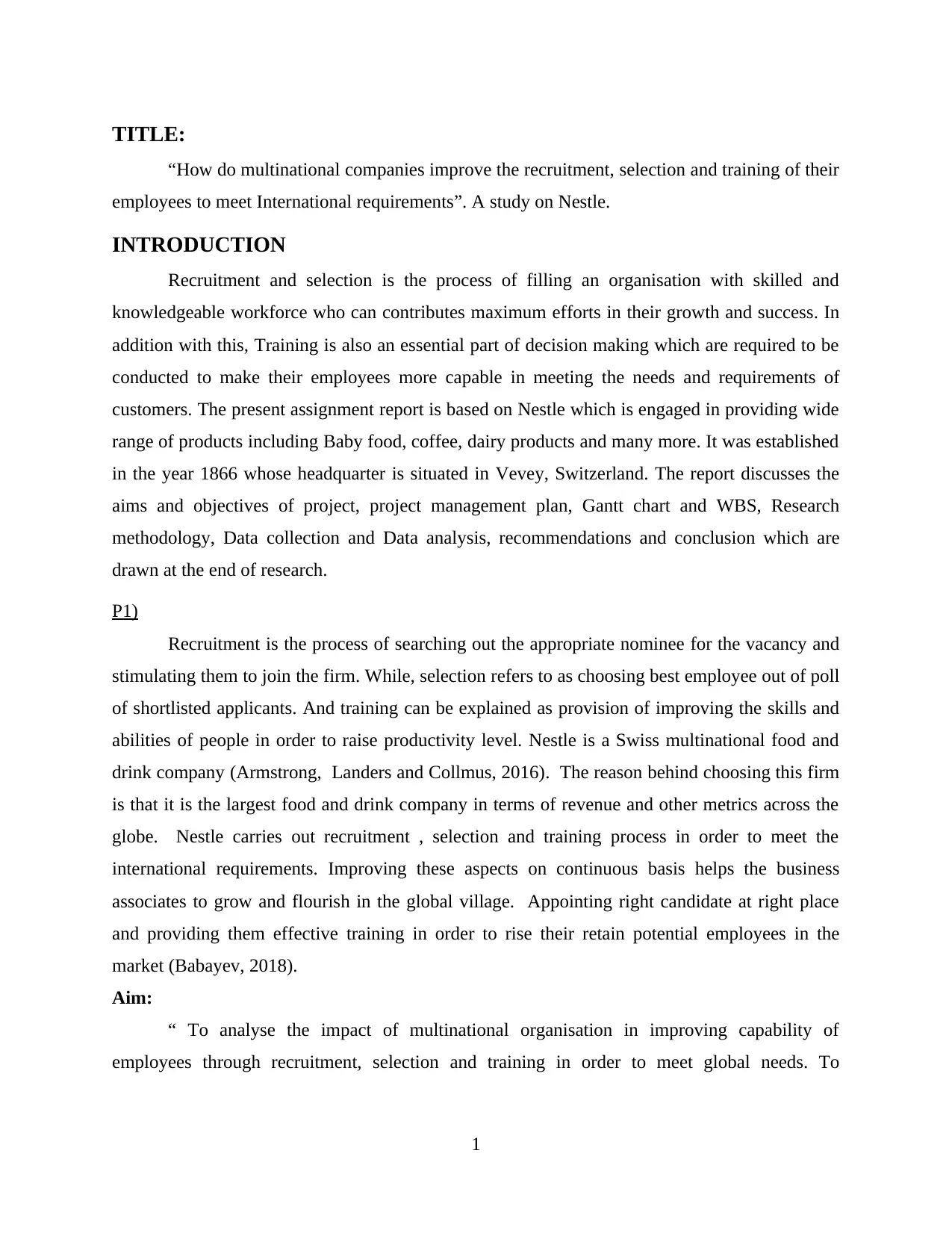
TITLE:
“How do multinational companies improve the recruitment, selection and training of their
employees to meet International requirements”. A study on Nestle.
INTRODUCTION
Recruitment and selection is the process of filling an organisation with skilled and
knowledgeable workforce who can contributes maximum efforts in their growth and success. In
addition with this, Training is also an essential part of decision making which are required to be
conducted to make their employees more capable in meeting the needs and requirements of
customers. The present assignment report is based on Nestle which is engaged in providing wide
range of products including Baby food, coffee, dairy products and many more. It was established
in the year 1866 whose headquarter is situated in Vevey, Switzerland. The report discusses the
aims and objectives of project, project management plan, Gantt chart and WBS, Research
methodology, Data collection and Data analysis, recommendations and conclusion which are
drawn at the end of research.
P1)
Recruitment is the process of searching out the appropriate nominee for the vacancy and
stimulating them to join the firm. While, selection refers to as choosing best employee out of poll
of shortlisted applicants. And training can be explained as provision of improving the skills and
abilities of people in order to raise productivity level. Nestle is a Swiss multinational food and
drink company (Armstrong, Landers and Collmus, 2016). The reason behind choosing this firm
is that it is the largest food and drink company in terms of revenue and other metrics across the
globe. Nestle carries out recruitment , selection and training process in order to meet the
international requirements. Improving these aspects on continuous basis helps the business
associates to grow and flourish in the global village. Appointing right candidate at right place
and providing them effective training in order to rise their retain potential employees in the
market (Babayev, 2018).
Aim:
“ To analyse the impact of multinational organisation in improving capability of
employees through recruitment, selection and training in order to meet global needs. To
1
“How do multinational companies improve the recruitment, selection and training of their
employees to meet International requirements”. A study on Nestle.
INTRODUCTION
Recruitment and selection is the process of filling an organisation with skilled and
knowledgeable workforce who can contributes maximum efforts in their growth and success. In
addition with this, Training is also an essential part of decision making which are required to be
conducted to make their employees more capable in meeting the needs and requirements of
customers. The present assignment report is based on Nestle which is engaged in providing wide
range of products including Baby food, coffee, dairy products and many more. It was established
in the year 1866 whose headquarter is situated in Vevey, Switzerland. The report discusses the
aims and objectives of project, project management plan, Gantt chart and WBS, Research
methodology, Data collection and Data analysis, recommendations and conclusion which are
drawn at the end of research.
P1)
Recruitment is the process of searching out the appropriate nominee for the vacancy and
stimulating them to join the firm. While, selection refers to as choosing best employee out of poll
of shortlisted applicants. And training can be explained as provision of improving the skills and
abilities of people in order to raise productivity level. Nestle is a Swiss multinational food and
drink company (Armstrong, Landers and Collmus, 2016). The reason behind choosing this firm
is that it is the largest food and drink company in terms of revenue and other metrics across the
globe. Nestle carries out recruitment , selection and training process in order to meet the
international requirements. Improving these aspects on continuous basis helps the business
associates to grow and flourish in the global village. Appointing right candidate at right place
and providing them effective training in order to rise their retain potential employees in the
market (Babayev, 2018).
Aim:
“ To analyse the impact of multinational organisation in improving capability of
employees through recruitment, selection and training in order to meet global needs. To
1
⊘ This is a preview!⊘
Do you want full access?
Subscribe today to unlock all pages.

Trusted by 1+ million students worldwide
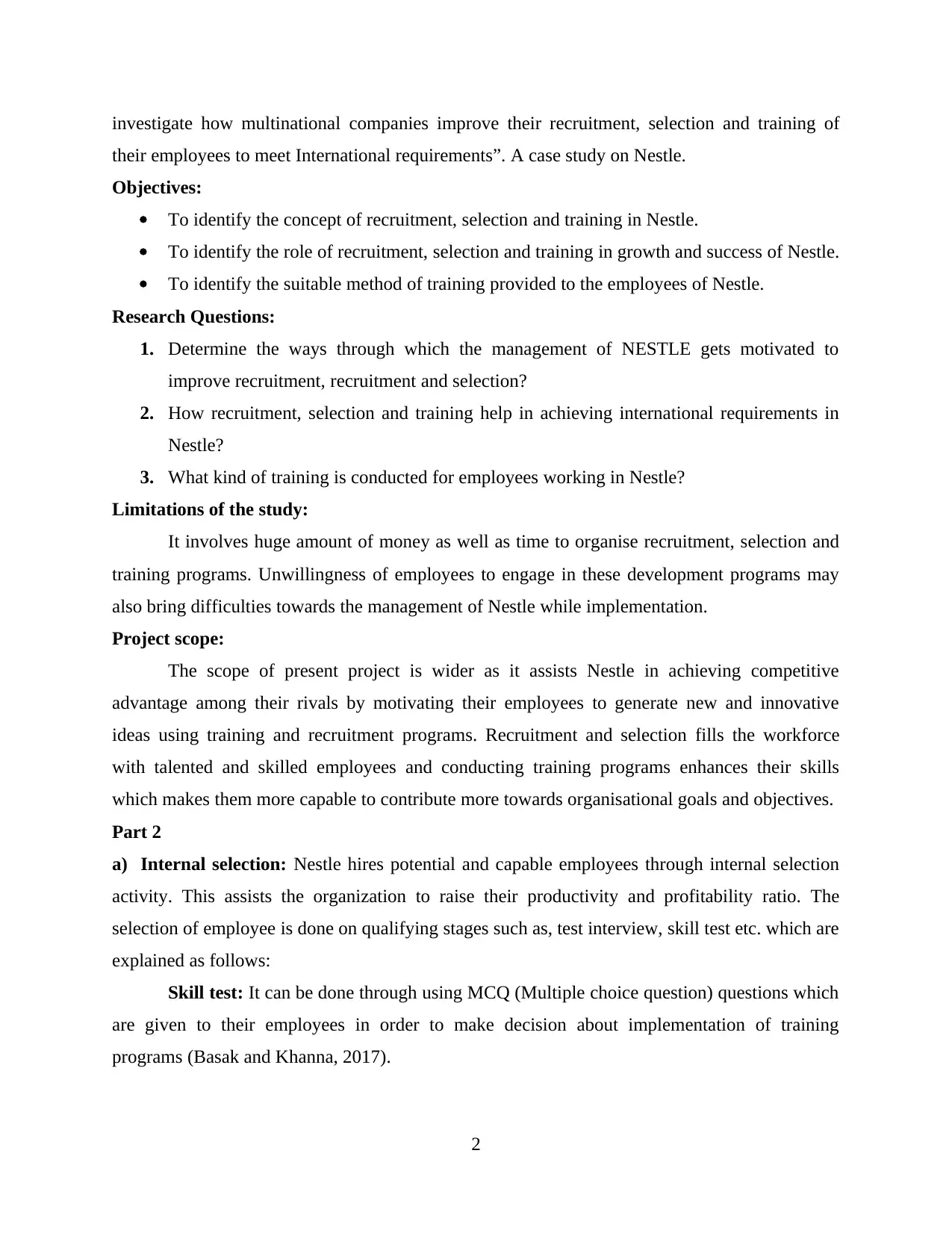
investigate how multinational companies improve their recruitment, selection and training of
their employees to meet International requirements”. A case study on Nestle.
Objectives:
To identify the concept of recruitment, selection and training in Nestle.
To identify the role of recruitment, selection and training in growth and success of Nestle.
To identify the suitable method of training provided to the employees of Nestle.
Research Questions:
1. Determine the ways through which the management of NESTLE gets motivated to
improve recruitment, recruitment and selection?
2. How recruitment, selection and training help in achieving international requirements in
Nestle?
3. What kind of training is conducted for employees working in Nestle?
Limitations of the study:
It involves huge amount of money as well as time to organise recruitment, selection and
training programs. Unwillingness of employees to engage in these development programs may
also bring difficulties towards the management of Nestle while implementation.
Project scope:
The scope of present project is wider as it assists Nestle in achieving competitive
advantage among their rivals by motivating their employees to generate new and innovative
ideas using training and recruitment programs. Recruitment and selection fills the workforce
with talented and skilled employees and conducting training programs enhances their skills
which makes them more capable to contribute more towards organisational goals and objectives.
Part 2
a) Internal selection: Nestle hires potential and capable employees through internal selection
activity. This assists the organization to raise their productivity and profitability ratio. The
selection of employee is done on qualifying stages such as, test interview, skill test etc. which are
explained as follows:
Skill test: It can be done through using MCQ (Multiple choice question) questions which
are given to their employees in order to make decision about implementation of training
programs (Basak and Khanna, 2017).
2
their employees to meet International requirements”. A case study on Nestle.
Objectives:
To identify the concept of recruitment, selection and training in Nestle.
To identify the role of recruitment, selection and training in growth and success of Nestle.
To identify the suitable method of training provided to the employees of Nestle.
Research Questions:
1. Determine the ways through which the management of NESTLE gets motivated to
improve recruitment, recruitment and selection?
2. How recruitment, selection and training help in achieving international requirements in
Nestle?
3. What kind of training is conducted for employees working in Nestle?
Limitations of the study:
It involves huge amount of money as well as time to organise recruitment, selection and
training programs. Unwillingness of employees to engage in these development programs may
also bring difficulties towards the management of Nestle while implementation.
Project scope:
The scope of present project is wider as it assists Nestle in achieving competitive
advantage among their rivals by motivating their employees to generate new and innovative
ideas using training and recruitment programs. Recruitment and selection fills the workforce
with talented and skilled employees and conducting training programs enhances their skills
which makes them more capable to contribute more towards organisational goals and objectives.
Part 2
a) Internal selection: Nestle hires potential and capable employees through internal selection
activity. This assists the organization to raise their productivity and profitability ratio. The
selection of employee is done on qualifying stages such as, test interview, skill test etc. which are
explained as follows:
Skill test: It can be done through using MCQ (Multiple choice question) questions which
are given to their employees in order to make decision about implementation of training
programs (Basak and Khanna, 2017).
2
Paraphrase This Document
Need a fresh take? Get an instant paraphrase of this document with our AI Paraphraser
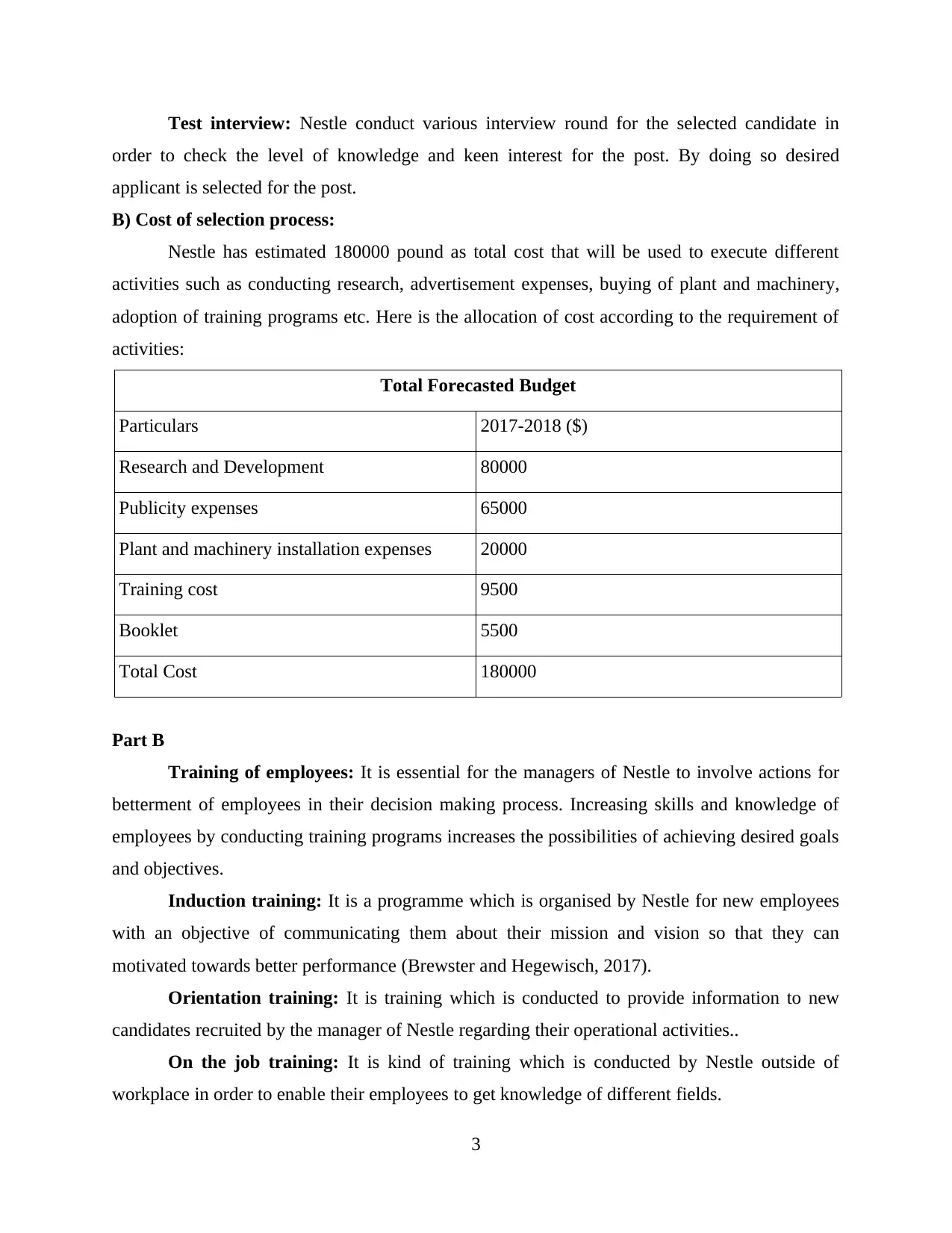
Test interview: Nestle conduct various interview round for the selected candidate in
order to check the level of knowledge and keen interest for the post. By doing so desired
applicant is selected for the post.
B) Cost of selection process:
Nestle has estimated 180000 pound as total cost that will be used to execute different
activities such as conducting research, advertisement expenses, buying of plant and machinery,
adoption of training programs etc. Here is the allocation of cost according to the requirement of
activities:
Total Forecasted Budget
Particulars 2017-2018 ($)
Research and Development 80000
Publicity expenses 65000
Plant and machinery installation expenses 20000
Training cost 9500
Booklet 5500
Total Cost 180000
Part B
Training of employees: It is essential for the managers of Nestle to involve actions for
betterment of employees in their decision making process. Increasing skills and knowledge of
employees by conducting training programs increases the possibilities of achieving desired goals
and objectives.
Induction training: It is a programme which is organised by Nestle for new employees
with an objective of communicating them about their mission and vision so that they can
motivated towards better performance (Brewster and Hegewisch, 2017).
Orientation training: It is training which is conducted to provide information to new
candidates recruited by the manager of Nestle regarding their operational activities..
On the job training: It is kind of training which is conducted by Nestle outside of
workplace in order to enable their employees to get knowledge of different fields.
3
order to check the level of knowledge and keen interest for the post. By doing so desired
applicant is selected for the post.
B) Cost of selection process:
Nestle has estimated 180000 pound as total cost that will be used to execute different
activities such as conducting research, advertisement expenses, buying of plant and machinery,
adoption of training programs etc. Here is the allocation of cost according to the requirement of
activities:
Total Forecasted Budget
Particulars 2017-2018 ($)
Research and Development 80000
Publicity expenses 65000
Plant and machinery installation expenses 20000
Training cost 9500
Booklet 5500
Total Cost 180000
Part B
Training of employees: It is essential for the managers of Nestle to involve actions for
betterment of employees in their decision making process. Increasing skills and knowledge of
employees by conducting training programs increases the possibilities of achieving desired goals
and objectives.
Induction training: It is a programme which is organised by Nestle for new employees
with an objective of communicating them about their mission and vision so that they can
motivated towards better performance (Brewster and Hegewisch, 2017).
Orientation training: It is training which is conducted to provide information to new
candidates recruited by the manager of Nestle regarding their operational activities..
On the job training: It is kind of training which is conducted by Nestle outside of
workplace in order to enable their employees to get knowledge of different fields.
3

Off the job training: It is kind of training which is conducted by Nestle within at
workplace with an objective of assisting employees in gaining knowledge of different techniques
that are currently used by an organisation in execution of different business process.
PART 4
P2
Project management plan can be defined as a blue print that consists of several aspects
such as scope, cost, quality etc. These plans are quite assistive for the organisation because they
help the researcher and project manager in determining the activities that have to be completed
by them within the project. Some of the aspects that should be consider by researcher or project
manager are given as below:
Cost: It can be defined as an amount that has to be invested so as to completing the chosen
project. Recruitment, selection and training are most important things for an organisation
because it not only increases the efficiency of employees but also support the organisation in
gaining competitive edge in marketplace. Researcher has demanded an amount of £100 for
executing research activities in effective manner (Dittmar, 2015).
Scope: It can be defined as the most crucial aspect through which managers of Nestle
will be able in determining the benefits that will be received after completing the project. In
context with project, scope is limited due to time bondage of 7 weeks and limited availability of
resources.
Time: It is also a crucial aspect of project management plan because without it pre-set
objectives or goals of firm will not be achieved in pre-determined time period that will directly
impact on the growth and success of Nestle in negative manner. For this project, researcher have
7 weeks of time frame for completing each and every research activity in a proper way (Heger
and Rohrbeck,2012).
Quality: It defines improvement in effectiveness after completion of project activities.
Researcher has to use qualitative methods so that project work can be performed appropriately.
this will automatically help them in constructing valid conclusion at the end of research
programme. To measure quality of project, number of filled questionnaires will be given
considerations.
4
workplace with an objective of assisting employees in gaining knowledge of different techniques
that are currently used by an organisation in execution of different business process.
PART 4
P2
Project management plan can be defined as a blue print that consists of several aspects
such as scope, cost, quality etc. These plans are quite assistive for the organisation because they
help the researcher and project manager in determining the activities that have to be completed
by them within the project. Some of the aspects that should be consider by researcher or project
manager are given as below:
Cost: It can be defined as an amount that has to be invested so as to completing the chosen
project. Recruitment, selection and training are most important things for an organisation
because it not only increases the efficiency of employees but also support the organisation in
gaining competitive edge in marketplace. Researcher has demanded an amount of £100 for
executing research activities in effective manner (Dittmar, 2015).
Scope: It can be defined as the most crucial aspect through which managers of Nestle
will be able in determining the benefits that will be received after completing the project. In
context with project, scope is limited due to time bondage of 7 weeks and limited availability of
resources.
Time: It is also a crucial aspect of project management plan because without it pre-set
objectives or goals of firm will not be achieved in pre-determined time period that will directly
impact on the growth and success of Nestle in negative manner. For this project, researcher have
7 weeks of time frame for completing each and every research activity in a proper way (Heger
and Rohrbeck,2012).
Quality: It defines improvement in effectiveness after completion of project activities.
Researcher has to use qualitative methods so that project work can be performed appropriately.
this will automatically help them in constructing valid conclusion at the end of research
programme. To measure quality of project, number of filled questionnaires will be given
considerations.
4
⊘ This is a preview!⊘
Do you want full access?
Subscribe today to unlock all pages.

Trusted by 1+ million students worldwide

Communication: This is also an effective part of project management plan that defines
importance of communication during the project activities. Researcher can use some effective
communication channels such as face to face communication with tutor and colleagues telephone
so that valid response can be received whereas to interact with employees in Nestle, researcher
can use telephone calls, E-mails etc. (Jeske and Shultz, 2016).
Risk - There are several risks such as lack of funds, resources and shortage of time-frame
that can be occurred at any time during the project. As the project is related with improvement in
training, selection and recruitment methods several risks can be faced by project managers such
as rules and regulation of government, cultural difference, communication barrier etc. whereas,
researcher can face risks such as shortage of funds, time etc.
Resources - With the help of resources, Nestle will be able in completing the project
effectively. Researcher have to allocate some resources such as internet connection, computer
systems, stationary so that any difficulty not be faced during the research programme. In
addition, effective allocation of resources will be beneficial for both researcher and project
managers in completing project and research activities efficiently and effectively.
LITERATURE REVIEW
Q1: Determine the ways through which the management of NESTLE gets motivated to
improve recruitment, recruitment and selection?
According to Basak and Khanna, (2017), Feedback is necessary to check the efficiency of
training, recruitment and selection in the organisation and also it is used to improve them.
Through feedback nestle get to know that the how much training is relevant for the employees or
how effective recruitment and selection procedure is conducted to hire best candidates. Through
it nestle find that where are they lacking.
Recruitment, selection and training of the organisation is also improved by the help of
performance appraisal because with the help of performance appraisal nestle compare actual
performance of the employees with the setting standards and find out the deviations that are
coming out and take corrective action in which they are lacking. From this nestle find about the
need of training.
2: How recruitment, selection and training help in achieving international requirements in
Nestle?
5
importance of communication during the project activities. Researcher can use some effective
communication channels such as face to face communication with tutor and colleagues telephone
so that valid response can be received whereas to interact with employees in Nestle, researcher
can use telephone calls, E-mails etc. (Jeske and Shultz, 2016).
Risk - There are several risks such as lack of funds, resources and shortage of time-frame
that can be occurred at any time during the project. As the project is related with improvement in
training, selection and recruitment methods several risks can be faced by project managers such
as rules and regulation of government, cultural difference, communication barrier etc. whereas,
researcher can face risks such as shortage of funds, time etc.
Resources - With the help of resources, Nestle will be able in completing the project
effectively. Researcher have to allocate some resources such as internet connection, computer
systems, stationary so that any difficulty not be faced during the research programme. In
addition, effective allocation of resources will be beneficial for both researcher and project
managers in completing project and research activities efficiently and effectively.
LITERATURE REVIEW
Q1: Determine the ways through which the management of NESTLE gets motivated to
improve recruitment, recruitment and selection?
According to Basak and Khanna, (2017), Feedback is necessary to check the efficiency of
training, recruitment and selection in the organisation and also it is used to improve them.
Through feedback nestle get to know that the how much training is relevant for the employees or
how effective recruitment and selection procedure is conducted to hire best candidates. Through
it nestle find that where are they lacking.
Recruitment, selection and training of the organisation is also improved by the help of
performance appraisal because with the help of performance appraisal nestle compare actual
performance of the employees with the setting standards and find out the deviations that are
coming out and take corrective action in which they are lacking. From this nestle find about the
need of training.
2: How recruitment, selection and training help in achieving international requirements in
Nestle?
5
Paraphrase This Document
Need a fresh take? Get an instant paraphrase of this document with our AI Paraphraser

According to Crane and Matten, (2016), Training is the procedure which providing
necessary skills to the employees that are required by the Nestle to perform a particular task or to
achieve particular goal. For internationally spread business nestle required more effective and
efficient employee to grow in foreign market and that is only possible by the help of effective
training. Nestle hire best candidates for the particular position which is done by proper
recruitment and selection. At nestle first all the applications are processed and then continued to
the stage of online test. This includes a situation based test, quantitative test and a telephonic
interview. After completing these stages final round of selection is face to face interview.
Through which nestle hire best candidates which contributes in international organisational
growth.
3: What kind of training is conducted for employees working in Nestle?
According to (Heger and Rohrbeck, 2012), Nestle mostly provide on the job training. In
this method of training teach all the competencies and knowledge which are required to perform
a particular task within the organisation. Nestle also provide purpose-oriented training which is
conducted for the specific purpose. In this formal and specific training programs are organised
by the nestle that is planned to improve the particular skills and knowledge. Other than these
training programs manager of nestle also responsible for their guidance and coaching which they
need to be provide to every employees of the organisation. All these training programs are
provided to the employees of the Nestle that helps to raise their competences and skills which are
required to perform every task of the company.
company.
P3
Work breakdown structure - This structure is used by the managers of organisation so
as to dividing the activities in small components so that each activity of project can be managed
or accomplish in easy manner. In other words, it is a structure in which all activity of project are
framed by the project managers so that desired outcomes will be received in pre-determined
time-frame. Furthermore, this is a progressive structure which is used by organisations so as to
executing the all project activities in pre-determined time period. In addition to this, this chart is
used to determine interrelationship between project activities and time period. In context of
Nestle, this structure will be prove beneficial for them as through using it they will be able in
framing the project activities as per the priority. With the help of this structure, managers of
6
necessary skills to the employees that are required by the Nestle to perform a particular task or to
achieve particular goal. For internationally spread business nestle required more effective and
efficient employee to grow in foreign market and that is only possible by the help of effective
training. Nestle hire best candidates for the particular position which is done by proper
recruitment and selection. At nestle first all the applications are processed and then continued to
the stage of online test. This includes a situation based test, quantitative test and a telephonic
interview. After completing these stages final round of selection is face to face interview.
Through which nestle hire best candidates which contributes in international organisational
growth.
3: What kind of training is conducted for employees working in Nestle?
According to (Heger and Rohrbeck, 2012), Nestle mostly provide on the job training. In
this method of training teach all the competencies and knowledge which are required to perform
a particular task within the organisation. Nestle also provide purpose-oriented training which is
conducted for the specific purpose. In this formal and specific training programs are organised
by the nestle that is planned to improve the particular skills and knowledge. Other than these
training programs manager of nestle also responsible for their guidance and coaching which they
need to be provide to every employees of the organisation. All these training programs are
provided to the employees of the Nestle that helps to raise their competences and skills which are
required to perform every task of the company.
company.
P3
Work breakdown structure - This structure is used by the managers of organisation so
as to dividing the activities in small components so that each activity of project can be managed
or accomplish in easy manner. In other words, it is a structure in which all activity of project are
framed by the project managers so that desired outcomes will be received in pre-determined
time-frame. Furthermore, this is a progressive structure which is used by organisations so as to
executing the all project activities in pre-determined time period. In addition to this, this chart is
used to determine interrelationship between project activities and time period. In context of
Nestle, this structure will be prove beneficial for them as through using it they will be able in
framing the project activities as per the priority. With the help of this structure, managers of
6
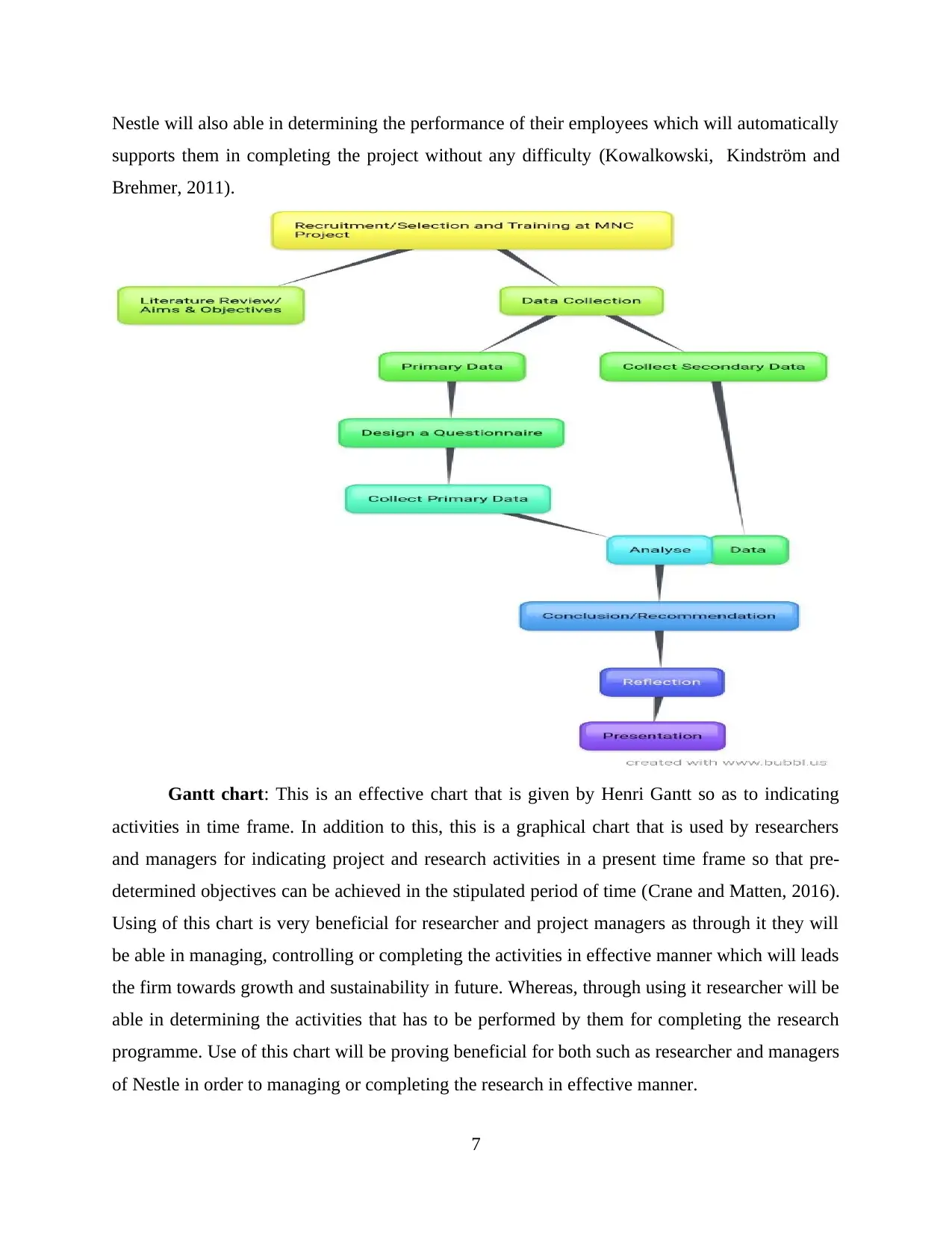
Nestle will also able in determining the performance of their employees which will automatically
supports them in completing the project without any difficulty (Kowalkowski, Kindström and
Brehmer, 2011).
Gantt chart: This is an effective chart that is given by Henri Gantt so as to indicating
activities in time frame. In addition to this, this is a graphical chart that is used by researchers
and managers for indicating project and research activities in a present time frame so that pre-
determined objectives can be achieved in the stipulated period of time (Crane and Matten, 2016).
Using of this chart is very beneficial for researcher and project managers as through it they will
be able in managing, controlling or completing the activities in effective manner which will leads
the firm towards growth and sustainability in future. Whereas, through using it researcher will be
able in determining the activities that has to be performed by them for completing the research
programme. Use of this chart will be proving beneficial for both such as researcher and managers
of Nestle in order to managing or completing the research in effective manner.
7
supports them in completing the project without any difficulty (Kowalkowski, Kindström and
Brehmer, 2011).
Gantt chart: This is an effective chart that is given by Henri Gantt so as to indicating
activities in time frame. In addition to this, this is a graphical chart that is used by researchers
and managers for indicating project and research activities in a present time frame so that pre-
determined objectives can be achieved in the stipulated period of time (Crane and Matten, 2016).
Using of this chart is very beneficial for researcher and project managers as through it they will
be able in managing, controlling or completing the activities in effective manner which will leads
the firm towards growth and sustainability in future. Whereas, through using it researcher will be
able in determining the activities that has to be performed by them for completing the research
programme. Use of this chart will be proving beneficial for both such as researcher and managers
of Nestle in order to managing or completing the research in effective manner.
7
⊘ This is a preview!⊘
Do you want full access?
Subscribe today to unlock all pages.

Trusted by 1+ million students worldwide
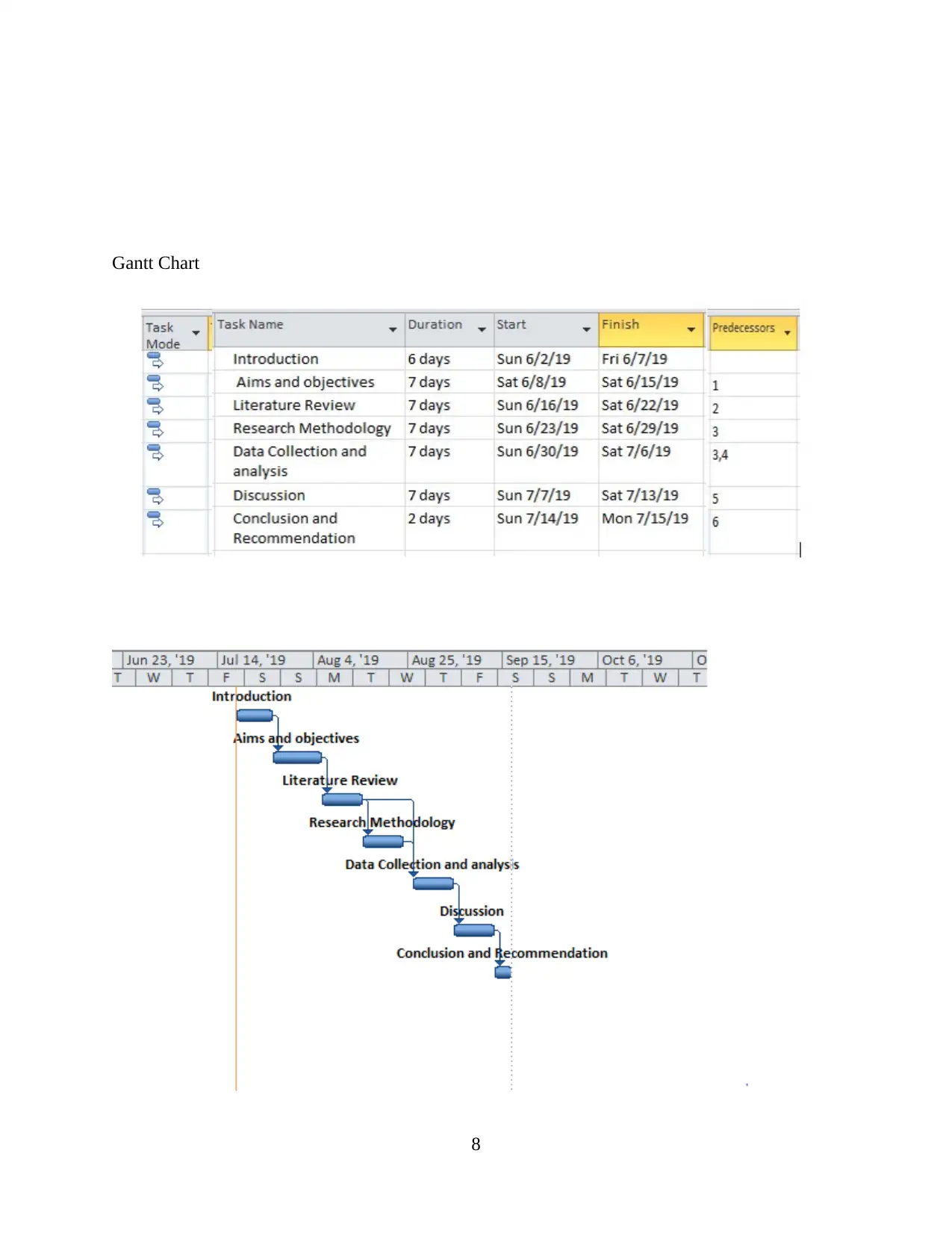
Gantt Chart
8
8
Paraphrase This Document
Need a fresh take? Get an instant paraphrase of this document with our AI Paraphraser

TASK 2
P4
Research methodology can be defined as an important part of project that is used by
researcher so as to collecting accurate information regarding the concept of training, recruitment
and selection methods. In it, researcher has to collecting in-depth information by using effective
methods so that objectives can be achieved in easy manner (Letsoalo and Mollel, 2016). In
addition to this, research methodology is a combination of activities that has to be done by
researcher in order to completing the research activities in appropriate manner. This is a very
useful process that assists the researcher in finding effective methods for competing the research
in appropriate manner. By doing this reliable and valid information will be gathered about the
topic of study. However, it highly supports the investigator in framing better conclusions at the
end of research but there are some risks that can be faced by researcher such as allocation of
resources, funds etc. so that it is very important for them to manage these risks effectively so that
better outcomes can be received at the end of research. There are some methods that should be
considered by researcher for completing research programme. These are given some as below:
Research philosophy: This is a belief that increases understanding of researcher about
the topic so that they will be able in collecting relevant data for the topic of study. Two kind of
philosophy are mainly used by researchers so as to completing the research appropriately. In
which positivism is not used by researcher in this project because it does not depends on
systematic manner whereas, it is used by researcher when there is a less time period and
researcher have to provide valuable results in a shorter period of time (Patterson Zibarras and
Ashworth, 2016). The second philosophy is related with interpretivism in which data has been
collected then analysed and interpreted so that reliable conclusion can be constructed at the end
9
P4
Research methodology can be defined as an important part of project that is used by
researcher so as to collecting accurate information regarding the concept of training, recruitment
and selection methods. In it, researcher has to collecting in-depth information by using effective
methods so that objectives can be achieved in easy manner (Letsoalo and Mollel, 2016). In
addition to this, research methodology is a combination of activities that has to be done by
researcher in order to completing the research activities in appropriate manner. This is a very
useful process that assists the researcher in finding effective methods for competing the research
in appropriate manner. By doing this reliable and valid information will be gathered about the
topic of study. However, it highly supports the investigator in framing better conclusions at the
end of research but there are some risks that can be faced by researcher such as allocation of
resources, funds etc. so that it is very important for them to manage these risks effectively so that
better outcomes can be received at the end of research. There are some methods that should be
considered by researcher for completing research programme. These are given some as below:
Research philosophy: This is a belief that increases understanding of researcher about
the topic so that they will be able in collecting relevant data for the topic of study. Two kind of
philosophy are mainly used by researchers so as to completing the research appropriately. In
which positivism is not used by researcher in this project because it does not depends on
systematic manner whereas, it is used by researcher when there is a less time period and
researcher have to provide valuable results in a shorter period of time (Patterson Zibarras and
Ashworth, 2016). The second philosophy is related with interpretivism in which data has been
collected then analysed and interpreted so that reliable conclusion can be constructed at the end
9
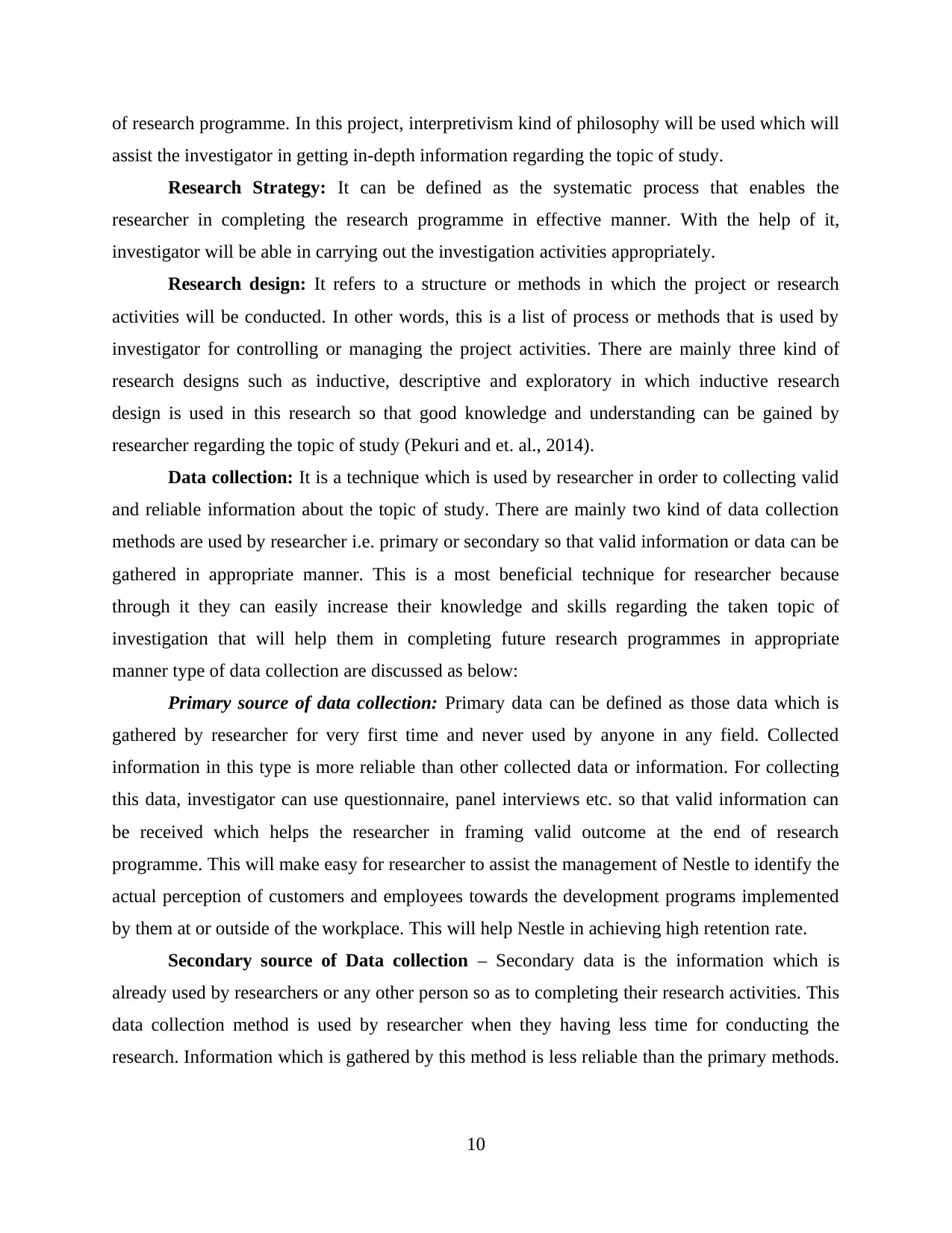
of research programme. In this project, interpretivism kind of philosophy will be used which will
assist the investigator in getting in-depth information regarding the topic of study.
Research Strategy: It can be defined as the systematic process that enables the
researcher in completing the research programme in effective manner. With the help of it,
investigator will be able in carrying out the investigation activities appropriately.
Research design: It refers to a structure or methods in which the project or research
activities will be conducted. In other words, this is a list of process or methods that is used by
investigator for controlling or managing the project activities. There are mainly three kind of
research designs such as inductive, descriptive and exploratory in which inductive research
design is used in this research so that good knowledge and understanding can be gained by
researcher regarding the topic of study (Pekuri and et. al., 2014).
Data collection: It is a technique which is used by researcher in order to collecting valid
and reliable information about the topic of study. There are mainly two kind of data collection
methods are used by researcher i.e. primary or secondary so that valid information or data can be
gathered in appropriate manner. This is a most beneficial technique for researcher because
through it they can easily increase their knowledge and skills regarding the taken topic of
investigation that will help them in completing future research programmes in appropriate
manner type of data collection are discussed as below:
Primary source of data collection: Primary data can be defined as those data which is
gathered by researcher for very first time and never used by anyone in any field. Collected
information in this type is more reliable than other collected data or information. For collecting
this data, investigator can use questionnaire, panel interviews etc. so that valid information can
be received which helps the researcher in framing valid outcome at the end of research
programme. This will make easy for researcher to assist the management of Nestle to identify the
actual perception of customers and employees towards the development programs implemented
by them at or outside of the workplace. This will help Nestle in achieving high retention rate.
Secondary source of Data collection – Secondary data is the information which is
already used by researchers or any other person so as to completing their research activities. This
data collection method is used by researcher when they having less time for conducting the
research. Information which is gathered by this method is less reliable than the primary methods.
10
assist the investigator in getting in-depth information regarding the topic of study.
Research Strategy: It can be defined as the systematic process that enables the
researcher in completing the research programme in effective manner. With the help of it,
investigator will be able in carrying out the investigation activities appropriately.
Research design: It refers to a structure or methods in which the project or research
activities will be conducted. In other words, this is a list of process or methods that is used by
investigator for controlling or managing the project activities. There are mainly three kind of
research designs such as inductive, descriptive and exploratory in which inductive research
design is used in this research so that good knowledge and understanding can be gained by
researcher regarding the topic of study (Pekuri and et. al., 2014).
Data collection: It is a technique which is used by researcher in order to collecting valid
and reliable information about the topic of study. There are mainly two kind of data collection
methods are used by researcher i.e. primary or secondary so that valid information or data can be
gathered in appropriate manner. This is a most beneficial technique for researcher because
through it they can easily increase their knowledge and skills regarding the taken topic of
investigation that will help them in completing future research programmes in appropriate
manner type of data collection are discussed as below:
Primary source of data collection: Primary data can be defined as those data which is
gathered by researcher for very first time and never used by anyone in any field. Collected
information in this type is more reliable than other collected data or information. For collecting
this data, investigator can use questionnaire, panel interviews etc. so that valid information can
be received which helps the researcher in framing valid outcome at the end of research
programme. This will make easy for researcher to assist the management of Nestle to identify the
actual perception of customers and employees towards the development programs implemented
by them at or outside of the workplace. This will help Nestle in achieving high retention rate.
Secondary source of Data collection – Secondary data is the information which is
already used by researchers or any other person so as to completing their research activities. This
data collection method is used by researcher when they having less time for conducting the
research. Information which is gathered by this method is less reliable than the primary methods.
10
⊘ This is a preview!⊘
Do you want full access?
Subscribe today to unlock all pages.

Trusted by 1+ million students worldwide
1 out of 34
Related Documents
Your All-in-One AI-Powered Toolkit for Academic Success.
+13062052269
info@desklib.com
Available 24*7 on WhatsApp / Email
![[object Object]](/_next/static/media/star-bottom.7253800d.svg)
Unlock your academic potential
Copyright © 2020–2025 A2Z Services. All Rights Reserved. Developed and managed by ZUCOL.





